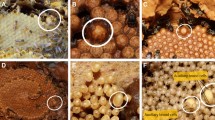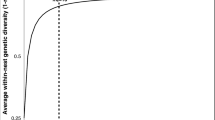Abstract
Pheromones are important in reproductive isolation among populations of moths, but the genetics associated with diversification of pheromonal signals is poorly understood. To gain insight into processes that may lead to diversification we examined the genetic architecture underlying the production of the sex pheromone of the cabbage looper moth, Trichoplusia ni. We compared genetic parameters of two populations; one with a wild-type pheromone phenotype (N) and one where a single-gene mutation affecting the pheromone blend produced by females had been established (M). Using a half-sib breeding design we estimated heritabilities, coefficients of additive genetic variation, and phenotypic, genetic, and environmental correlations of the pheromone components. In both populations, narrow sense heritabilities were generally moderate and genetic correlations were mostly positive. Comparisons between the two populations showed that, while the pattern of phenotypic correlations showed significant agreement between populations, the patterns of genetic (co)variation (i.e. the shapes of the within population matrix) were dissimilar between the two populations. The presence of additive genetic variation in both populations indicates that there is the potential for further evolution of individual pheromone components. However, because of the differences between the populations in the pattern of genetic variation and covariation, the populations will evolve along different evolutionary trajectories even under identical selection pressures. These results suggest that single gene mutations, once established, can be associated with further alterations in the genetic architecture and this has implications for the evolution of pheromone communication.
Similar content being viewed by others
REFERENCES
Arn, H., Tóth, M., and Priesner, E. (1999). The Pherolist. Internet Edition. http://www.nysaes.cornell.edu/pheronet.
Arnold, S. J. (1994). Multivariate inheritance and evolution: a review of concepts. In: Boake, C. R. B. Quantitative Genetic Studies of Behavioral Evolution. University of Chicago Press, Chicago. pp. 17–48.
Becker, W. A. (1984). Manual of Quantitative Genetics, 4th edn. Academic Enterprises, Pullman, Washington.
Bjostad, L. B., Linn, C. E., Du, J. W., and Roelofs, W. L. (1984). Identification of new sex pheromone components in Trichoplusia ni, predicted from biosynthetic precursors. J.Chem.Ecol. 10: 1309–1323.
Boake, C. R. B. (1991). Coevolution of senders and receivers of sexual signals: genetic coupling and genetic correlations. Trends Ecol.Evol. 6: 225–227.
Buckley, S. H., Tregenza, T., and Butlin, R. K. (1997). Speciation and signal trait genetics. Trends Ecol.Evol. 12: 299–301.
Butlin, R. K., and Ritchie, M. G. (1989). Genetic coupling in mate recognition systems: what is the evidence? Biol.J.Linn.Soc. 37: 237–246.
Butlin, R. K., and Trickett, A. (1997). Can population genetic simulations help to interpret pheromone evolution? In: Cardé, R. T. and Minks, A. K. Insect Pheromone Research: New Directions. Chapman & Hall, New York. pp. 548–562.
Cardé, R. T., and Baker, T. C. (1984). Sexual communication with pheromones. In: Bell, W. J. and Cardé, R. T. Chemical Ecology of Insects. Chapman & Hall, New York. pp. 355–383.
Cardé, R. T., Cardé, A. M., Hill, A. S., and Roelofs, W. L. (1977). Sex pheromone specificity as a reproductive isolating mechanism among the sibling species Archips argyrospilus and A.mortuanus and other sympatric tortricine moths (Lepidoptera: Tortricidae). J.Chem.Ecol. 3: 71–84.
Cheverud, J. M., Wagner, G. P., and Dow, M. M. (1989). Methods for the comparative analysis of variation patterns. Syst.Zool. 38: 201–213.
Collins, R. D., and Cardé, R. T. (1985). Variation and heritability aspects of pheromone production in the pink bollworm moth, Pectinophora gossypiella (Lepidoptera: Gelechiidae). Ann.Entomol.Soc.Am., 78: 229–234.
Collins, R. D., and Cardé, R. T. (1989). Selection for altered pheromone-component ratios in the pink bollworm moth, Pectinophora gossypiella (Lepidoptera: Gelechiidae). J.Insect Behav. 2: 609–621.
Collins, R. D., and Cardé, R. T. (1990). Selection for increased pheromone titre in the pink bollworm moth, Pectinophora gossypiella (Lepidoptera: Gelechiidae). Physiol.Entomol. 15: 141–147.
Coyne, J. A. (1992). Genetics and speciation. Nature. 355: 511–515.
Coyne, J. A., Crittenden, A., and Mah, K. (1994). Genetics of pheromonal difference contributing to reproductive isolation in Drosophila. Science 265: 1461–1464.
Foster, S. P., Muggleston, S. J., Löfstedt, C., and Hansson, B. (1997). A genetic study on pheromonal communication in two Ctenopseustis moths. In: Cardé, R. T. and Minks, A. K. Insect Pheromone Research: New Directions. Chapman & Hall, New York. pp. 514–524.
Goodnight, C. J., and Schwartz, J. M. (1997). A bootstrap comparison of genetic covariance matrices. Biometrics 53: 1026–1039.
Greenfield, M. D., and Karandinos, M. G. (1979). Resource partitioning of sex pheromone communication channel in clearwing moths (Lepidoptera: Sesiidae) of Wisconsin. Ecol.Monogr. 49: 403–426.
Haynes, K. F. (1997). Genetics of pheromone communication in the cabbage looper moth, Trichoplusia ni. In: Cardé, R. T. and Minks, A. K. Insect Pheromone Research: New Directions. Chapman & Hall, New York. pp. 525–534.
Haynes, K. F., and Hunt, R. E. (1990a). Interpopulational variation in emitted phermone blend of cabbage looper moth, Trichoplusia ni. J.Chem.Ecol. 16: 509–519.
Haynes, K. F., and Hunt, R. E. (1990b). A mutation in pheromonal communication of cabbage looper moth, Trichoplusia ni. J.Chem.Ecol. 16: 1249–1257.
Houle, D. (1992). Comparing evolvability and variability of quantitative traits. Genetics 130: 195–204.
Hunt, R. E., and Haynes, K. F. (1990). Periodicity in the quantity and blend ratios of pheromone components in glands and volatile emissions of mutant and normal cabbage looper moths, Trichoplusia ni. J.Insect Physiol. 36: 769–774.
Hunt, R. E., Zhao, B., and Haynes, K. F. (1990). Genetic aspects of interpopulational differences in the pheromone blend of the cabbage looper moth, Trichoplusia ni. J.Chem.Ecol. 16: 2935–2946.
Klun, J. A., and Maini, S. (1979). Genetic basis of an insect chemical communication system: the European corn borer. Environ.Entomol. 8: 423–426.
Lande, R. (1979). Quantitative genetic analysis of multivariate evolution applied to brain: body size allometry. Evolution 33: 402–416.
Linn, C. E., Bjostad, L. B., Du, J. W., and Roelofs. W. L. (1984). Redundancy in a chemical signal: behavioral responses of male Trichoplusia ni to a 6-component sex pheromone blend. J.Chem.Ecol. 10: 1635–1658.
Liu, Y-B., and Haynes, K. F. (1994). Evolution of behavioral responses to sex pheromone in mutant laboratory colonies of Trichoplusia ni. J.Chem.Ecol. 20: 231–238.
Löfstedt, C. (1990). Population variation and genetic control of pheromone communication systems in moths. Entomol.Exp.Appl. 54: 199–218.
Löfstedt, C. (1993). Moth pheromone genetics and evolution. Phil.Trans.Roy.Soc.London B 340: 167–177.
Lynch, M. (1999). Estimating genetic correlations in natural populations. Genet.Res. 74: 255–264.
Lynch, M., and Walsh, B. (1998). Genetics and Analysis of Quantitative Traits. Sinauer Assoc., Sunderland MA.
Moore, A. J. (1997). The evolution of social signals: morphological, functional and genetic integration of the sex pheromone in Nauphoeta cinerea. Evolution 51: 1920–1928.
Phelan, P. L. (1992). Evolution of sex pheromones and the role of asymmetric tracking. In: Roitberg, B. D. and Isman, M. B. Insect Chemical Ecology: An Evolutionary Approach. Chapman & Hall, New York. pp. 265–314.
Pomiankowski, A., and Møller, A. P. (1995). A resolution of the lek paradox. Proc.Roy.Soc.London B 260: 21–29.
Roelofs, W. L., and Comeau, A. (1969). Sex pheromone specificity: taxonomic and evolutionary aspects in Lepidoptera. Science 165: 398–400.
Roelofs, W. L., Glover, T., Tang, X-T., Sreng, I., Robbins, P., Eckenrode, C., Löfstedt, C., Hansson, B., and Bengtsson, B. O. (1987). Sex pheromone production and perception in European corn borer moths is determined by both autosomal and sexlinked genes. Proc.Natl.Acad.Sci. USA 84: 7585–7589.
Roff, D. A. (1997). Evolutionary Quantitative Genetics. Chapman & Hall, New York.
Sanders, C. J. (1971). Sex pheromone specificity and taxonomy of budworm moths (Choristoneura). Science 171: 911–913.
Shorey, H. H., and Hale, R. L. (1965). Mass-rearing of the larvae of nine noctuid species on a simple artificial medium. J.Econ.Entomol. 58: 522–524.
Sreng, I., Glover, T., and Roelofs, W. L. (1989). Canalization of the redbanded leafroller moth sex pheromone blend. Arch.Insect Biochem.Physiol. 10: 73–82.
Tumlinson, J. H., Yonce, C. E., Doolittle, R. E., Heath, R. R., Gentry, C. R., and Mitchell, E. R. (1974). Sex pheromones and reproductive isolation of the lesser peachtree borer and the peachtree borer. Science 185: 614–616.
Author information
Authors and Affiliations
Rights and permissions
About this article
Cite this article
Gemeno, C., Moore, A.J., Preziosi, R.F. et al. Quantitative Genetics of Signal Evolution: A Comparison of the Pheromonal Signal in Two Populations of the Cabbage Looper, Trichoplusia ni. Behav Genet 31, 157–165 (2001). https://doi.org/10.1023/A:1010249310366
Issue Date:
DOI: https://doi.org/10.1023/A:1010249310366




